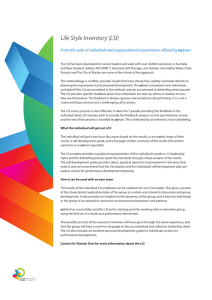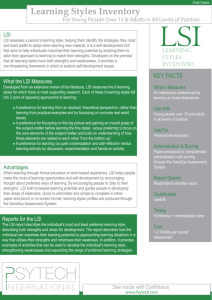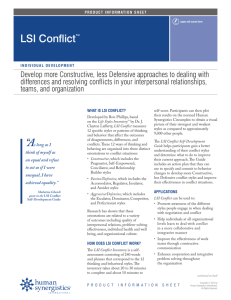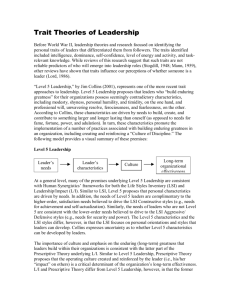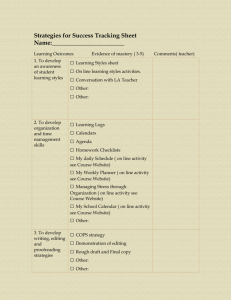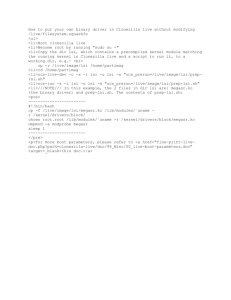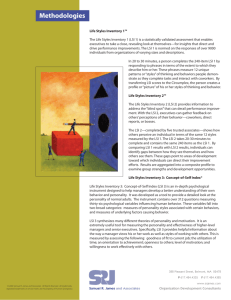Self-Directed Learning Pack No. 3
advertisement
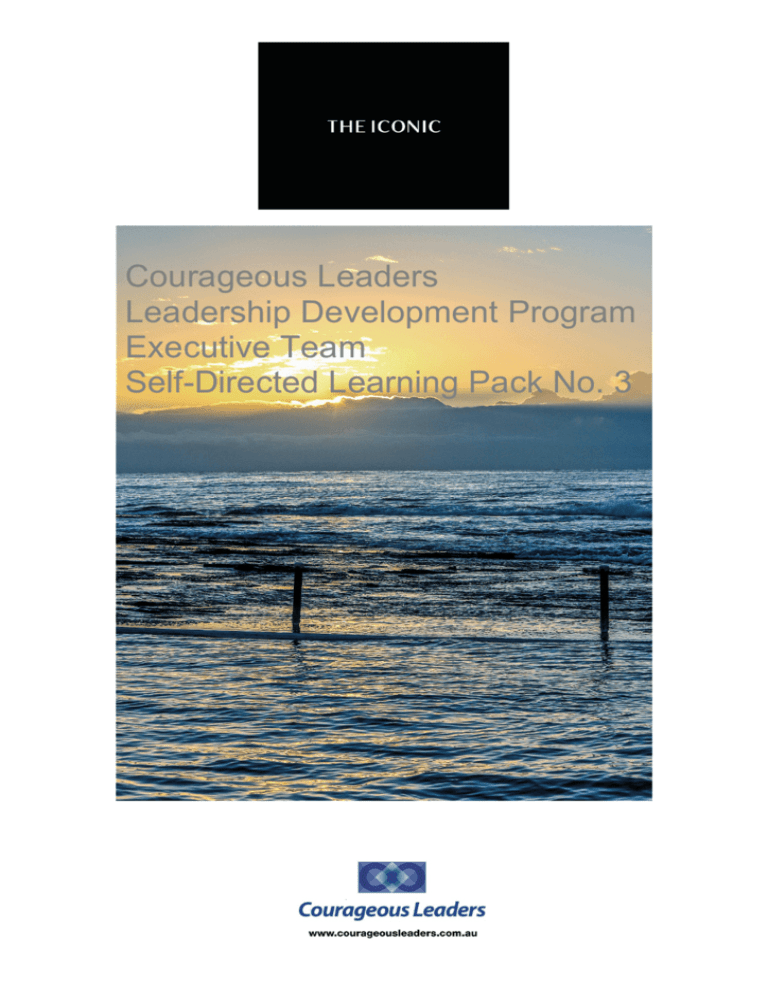
Courageous Leaders Leadership Development Program Executive Team Self-Directed Learning Pack No. 3 Self-Directed Learning Pack No. 3 Issued at end of Module D Each workshop is supported with a Self-Directed Learning Pack where you are encouraged to: • • Continue learning from the modules you have completed to date; and Frame your learning for the future modules yet to be completed (not applicable at this time.) Working your way through the Self Directed Learning Pack you are encouraged to think, read, explore and complete activities that stretch your capabilities as a leader of self, others and the organisation. By self-directing your learning you create the best opportunities for transformation of the way you lead the business. This pack supports the continuation of your learning from Modules A, B, C and D. 1. Continue your learning 1.1 1.2 1.3 1.4 Module A: Self Awareness Module B: Managing Myself Module C: Working in a Team Module D: Managing and Leading “The worth of a [program] is to be measured by what you can carry away from it.” James Bryce © Page 2 Self-Directed Learning Pack No. 3 1. Continue your learning 1.1 Module A: Self Awareness Issued at end of Module D Dive deeper into your understanding Continue to set aside reflective thinking time each week to focus on how your MBTI preferences are showing up when you work in a team. Record these observations in your learning journal and regularly connect with your Special Learning Partners to share what you are noticing. 1.2 Module B: Managing Myself Interacting in a team Continue to rattle your cage to bring awareness about the choices you make when managing yourself: 1.3 • Your focus – goals and values • Your time – finite resources • Your energy – renewable resource • Your workflow – delegation of tasks to people. Module C: Working in a Team To continue stretching your learning from Module C focus on these three key areas: 1. High Performing Team Continue to take 5 minutes after a meeting to reflect on the behaviours you “observed” during the meeting and the impact they had on you and on others. Importantly reflect on the behaviours you chose and determine what LSI 1 thinking style was responsible. 2. Behaviours you bring to the team Continue to dive deep into your Human Synergistics Combined Self Development Guide to make sense of your LSI 1 feedback. By now you should be noticing and feeling your primary and secondary styles when they play out in your personal thinking. Continue to stretch your constructive thinking styles with clearly identified actions in the more common situations you find yourself in on a daily basis. 3. Teams need a firm GRIP Continue putting GRIP into action with your teams and reflect on the difference this makes. Having more GRIP conversations throughout the organisation will certainly ensure your teams operate in the high performing space. 1.4 Module D: Managing and Leading Use your Human Synergistics Combined Self Development Guide to make sense of your LSI 2 feedback analysing the differences from and similarities with your LSI 1 feedback. Compare and explore the primary and secondary styles from your LSI 1 and LSI 2 reports. Particularly draw your attention to the LSI 1 and 2 Summary Grid © Page 3 Self-Directed Learning Pack No. 3 Issued at end of Module D on page 17 of your LSI 2 report – prioritising your Blind spots and unrecognised strengths as areas for development. To continue your development please invest time and energy thinking about how you want to “get into the blue” with the following four tables. Make decisions about the changes you are prepared to make as you continue your leadership development journey. Use your Human Synergistics Combined Self Development Guide to guide your thinking deeper by starting with your blind spots and reading about the styles and selecting suggestions from their page entitled “Becoming more effective – change suggestions” Achievement This is where you want to go and where you want to take your team Core purpose linked to specific goals 1. Make setting goals a habit by using GRIP when engaging with others in your team and with your manager/leader; and always have clarity on how the operational links with your core purpose as a leader in the business Generate outcomes 2. Target your effort where you know it counts and you have the responsibility and the accountability to generate outcomes Look for new ways to achieve outcomes 3. Instead of doing something the same way you have always done it – challenge yourself and others in your team to find another way – take a “measured” risk See mistakes as an opportunity to learn 4. Admit your mistakes openly and encourage others to do the same – start to see these negative experiences as opportunities to learn Use achievement oriented language 5. Focus on what CAN be done; what is realistic; highlight the opportunity and refer to ambition © Page 4 Self-Directed Learning Pack No. 3 Issued at end of Module D Self-Actualising This is the kind of leader and the kind of person I want to be to create personal and organisational success Generate clarity on your personal brand 1. Set aside regular time to explore your MBTI preferences, your values and your LSI thinking styles that generate your behavioural choices and assess how they align with the kind of leader you really want to be – hold yourself accountable Think the best of others 2. Stop judging people and start thinking the best of their intent and what they bring to create innovative outcomes Live in the present 3. Make a focussed effort to drop your baggage and invest your energy in “being” in the present and enjoying those moments for what they bring you Manage your time and energy 4. Take responsibility for your choices and stop blaming lack of time for what you are not capable of doing Seek out opportunities for growth 5. Be curious and be open to learning opportunities that present themselves to you each day Humanistic Encouraging This is how you will support the people you bring along on your journey Encourage others to be at their best Involve others Show gratitude and appreciation Encourage others to see mistakes as an opportunity to learn Engage in leverage cycle conversations 1. Find ways to engage with people to explore how they bring their best to what they do and to the team – listen, ask questions, observe with the intent of giving feedback 2. Encourage and allow others to take ownership – of decisions, of tasks, of problems, of a project. Encourage them to grow and to stretch 3. Invest the energy and the time to tell people how much you appreciate what they have achieved for you, the team and themselves 4. Be active in using mistakes as a great learning tool to create the learning agility you need in your team if it is to achieve, with people being self-actualised! 5. Invest the energy and the time to engage in leverage cycle conversations so you set people up to work at their best and deliver great outcomes © Page 5 Self-Directed Learning Pack No. 3 Issued at end of Module D Affiliative This is all about the people you care about and want to have join you Show empathy Care about what is happening for the other person 1. Listen with the intent to really understand by ensuring what they wanted you to receive is what you have actually received (eliminate roadblocks) 2. Ask questions and get to know what is happening for them while they work in the team to deliver the results – connect at a very “real” level Show warmth and social connection 3. Be aware of your body language – try smiling more often, showing positive connectivity to the person Exercise emotional resilience Clarity on interpersonal effectiveness 4. Recognise your emotions and get them under control before you assert them constructively 5. When engaging in a GRIP conversation make sure you cover off on the I in the depth it requires so you develop clarity on how you will value each other and ensure there is balanced participation © Page 6

